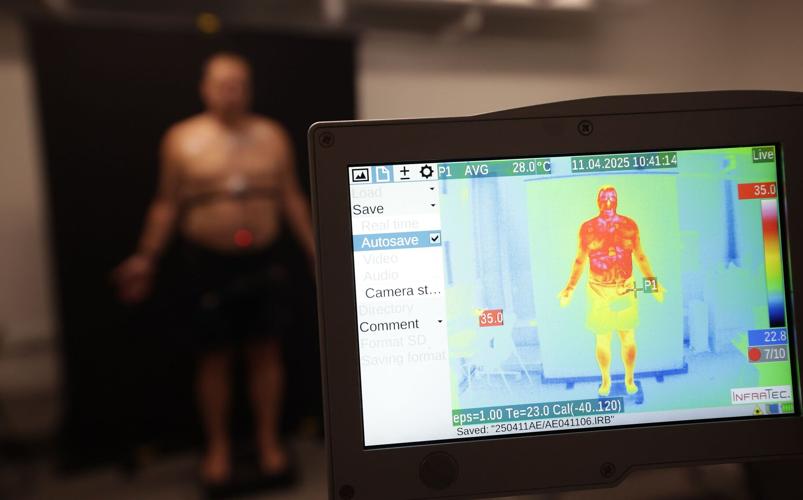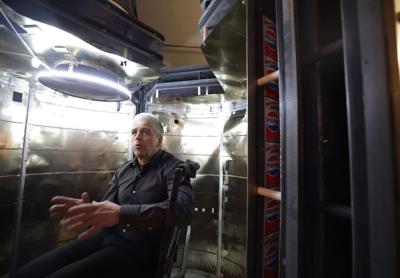OTTAWAÔÇöIn late spring, as cities made plans to protect their residents from summer’s heat, Glen Kenny walked into an apartment that felt like 53 C, shut the door and did not emerge for three straight days.┬á
It was not the first time Kenny had purposely exposed himself to temperatures increasingly understood to be dangerous. Nor was it the second, or the third.
He lost track when it was getting near a thousand, and that was a few years ago. 
As part of an investigation into the effects of extreme heat, ╔ź╔ź└▓ StarÔÇÖs climate change reporter Kate Allen visited Glen Kenny's lab at the University of Ottawa where she spent time inside a heat chamber that measures how much heat the body is emitting.┬á
Danger is the whole point. Kenny is a scientist at the University of Ottawa whose work ÔÇö on study participants, and on himself ÔÇö has upended assumptions about how the human body responds to extreme heat.┬áHe has particularly focused on workers, and understanding why one person’s uncomfortably hot day can be another’s life-threatening emergency.┬á┬á
“It’s not just having policies to protect them while they’re on the job. It’s also policies to ensure that they are going to be healthy throughout their lifespan,” Kenny says.
Climate changes, but policy does not
As heat waves intensify, so does the risk. A ╔ź╔ź└▓ Star investigation found that critical workplace injuries spike on the hottest days of the summer, in temperatures that are expected to become increasingly common because of climate change.
But while the climate has shifted rapidly, Ontario’s plan to protect workers has not. The Ministry of Labour helped pay for research in Kenny’s lab that exposed gaps in protections for swathes of the workforce. Kenny is frustrated this hasn’t translated into substantive changes.
“We’re in their backyard. We’ve been doing this for years. We’ve published hundreds and hundreds of papers,” Kenny says.
“But the government of Ontario, our government, continues to use the same old, same old approach.”
Living through a heat wave
Inside the studio apartment where Kenny sequestered himself in early June, the furnishings resemble any other living space. The room contains a bed, TV and kitchenette, where Kenny would prepare himself a bagel or crackers and cheese. It was too hot to stomach much else. 
Outside, it is obvious this is actually a laboratory on a university campus. Beyond the apartment’s “front door,” instrumentation allows the team to dial in the temperature and humidity precisely, to simulate the experience of living through a heat wave.
For Kenny’s three-day exposure in early June, the fifth of six sessions across 12 months, the apartment’s daytime temperature was set to 40 C at 45 per cent humidity, which feels like 53. This setting was deliberate: it mimicked the conditions of the 2021 western heat dome, which killed 619 British Columbians and which the federal government says is Canada’s deadliest weather event.┬á
Kenny, 61, has directed the Human and Environmental Physiology Research Unit for 25 years, and partially credits his upbringing for his focus on workers. His father was a pilot in the Royal Canadian Air Force, a job with intense stressors, and his mother was an incredibly hard-working military spouse. 
Kenny himself has a salt-and-pepper buzz cut, a military bearing, and drops NASCAR references into conversation, none of which are particularly common on university campuses. Asked to give an “MTV Cribs” style tour of his lab, he appeared unfamiliar with the concept, asking: “What do you mean?”
But his most atypical feature is his propensity to include himself in his lab’s research, which otherwise focuses on trials involving recruited study participants. He undertakes these one-man case studies, and has joined workers in mines underground and on electrical utility lines, to understand the “lived experience” of heat ÔÇö and to ensure his research is actually practical in the real world and for the people who need it most.┬á
This is a priority he finds lacking elsewhere. Lately, he has fielded calls about the FIFA World Cup, and concerns climate change will make some matches too hot for athletes. He agrees with these concerns, but thinks they are missing the bigger story.
“What about those workers that are exposed day in, day out? That’s their life,” he said.┬á
“They don’t have the luxury of being an athlete and taking 24 or 48 hours of recovery. No, their bosses want them there Tuesday morning, 6 a.m. sharp ÔÇö do your daylong work in the heat. Well, what protection are we providing them? How are we making them healthy?”
A unique tool for a unique job
To tackle these questions, Kenny has relied on a unique tool. But getting it into his lab nearly derailed his career. 

A direct-air calorimeter that provides a way to how the body is responding to extreme temperatures by measuring how much sweat is evaporating and how much heat is being transferred between the personÔÇÖs body and the environment.
Steve Russell ╔ź╔ź└▓ StarIn the 1990s, Kenny heard about a chamber designed to measure body heat that had been built in the 1970s at Memorial University of Newfoundland, but later mothballed and put in storage. Known as a direct-air calorimeter, it provides a way to very precisely map how the body is responding to extreme temperatures┬áby measuring how much sweat is evaporating and how much heat is being transferred between the personÔÇÖs body and the environment. Kenny compares it to an MRI, but for how the body thermoregulates, its process for maintaining a stable internal temperature.
Kenny arranged for the chamber to be shipped to Ottawa. But once it arrived, a chunk of the university building’s exterior had to be removed for the chamber to be craned inside: “insane,” he says. He also discovered that the internal mechanics were mouldy and needed to be rebuilt.┬á
“Of course, my dean was not happy when she found that out. She gave me I think it was about a year to get it fixed, or I figured I might be gone.”
Kenny needed to find $2.5 million. He ended up getting it from the U.S. military, which was reckoning with an increasingly powerful adversary.
The military feels the heat
Dispatches from the wars in Iraq and Afghanistan inevitably feature gunfire and rockets. But fighting forces faced another, silent threat. The U.S. army saw an eightfold increase in hospitalizations from heat stroke over roughly two decades. In the August 2004 battle of Najaf, 10 per cent of fighters were incapacitated from heat stress and had to be evacuated, a NATO task force found. 
“Heat illnesses often deplete forward medical support,” the task force reported.
The funding allowed Kenny to provide data to the military that improved guidance for how long troops could stay exposed to extreme temperatures before risking serious harm, and to contribute to research that reshaped our understanding of how hot the human body really gets. 

The calorimeter has been used in more than 150 major studies, making up for the trouble it took to get it into the university’s building.
Steve Russell ╔ź╔ź└▓ StarHe has since used the calorimeter in more than 150 major studies, making up for the trouble it took to get there.
“It paid huge dividends,” Kenny says.
“Had I not done that, we wouldn’t be doing the work we’re doing now.”
Rising temperatures and an aging workforce
Military troops consist primarily of young, healthy men. Canada’s workforce does not: the number of “mature” workers over age 55 has increased by 184 per cent since 2000, a Labour Market Information Council report found. Older adults are working longer and retiring later, and not just in air-conditioned office jobs. Trades, transport and equipment operators are among the occupations with the most skewed age ratios, and which are heavily dependent on older workers. The increase in older working women is even bigger than the increase in older working men.┬á
Yet the guidelines considered the gold standard for workplace heat limits were primarily validated in young, healthy men. Did those guidelines actually protect this expanding and important group of older workers?
Kenny’s lab designed a study that recruited nine men in their 50s and 60s and had them cycle in the calorimeter in very high temperatures similar to a heat wave, working and then stopping for breaks as the guidelines prescribed. None of the men maintained the stable core temperature that the guidelines are meant to ensure, .
While the experiment was capped at two hours, projections showed that half the participants would have experienced “catastrophic” outcomes if they had continued for four hours.┬á
In another experiment, Kenny’s lab had older men simulate a day of work in high temperatures ┬áand then measured their heat loss capacity in the calorimeter, and then repeat it again the next day. The study showed the men’s ability to compensate for the heat was impaired after back-to-back days of exertion.
Kenny has also investigated sex differences, and contributed to a growing body of evidence that shows women respond to heat exposure differently from men. In a 2020 study, the lab found that women who exercised in 40 C heat in the calorimeter lost less body heat than men in the same trial, and that those differences persisted in both young and old participants. 

Kenny has also investigated sex differences, and contributed to a growing body of evidence that shows women respond to heat exposure differently from men.
Steve Russell ╔ź╔ź└▓ StarThe Ontario government provided funding for all three of these studies, among others, including through grants targeted at occupational health and safety priorities. But despite its investment alongside other funding bodies in research,┬ácritics have charged that the province’s plan to keep workers safe from extreme heat is insufficient in practice.
Where are Ontario’s proposed new rules?
In addition to the spike in injuries on superhot days, the Star’s investigation found┬áthat the way Ontario tracks worker deaths overlooks fatalities that could be heat-related, even when provincial officials find evidence of heat exposure on the job.
Doctors groups and legal clinics have called on the Ontario coroner to change how it tracks all heat-related deaths, following the lead of British Columbia’s Coroners Service, whose heat-related death investigations have provided granular evidence that influenced policies.
An analysis of 13  years of critical injury data obtained by the Star shows heat poses a growing threat.
An analysis of 13  years of critical injury data obtained by the Star shows heat poses a growing threat.
Two summers ago, the Ministry of Labour proposed new heat stress protections that would, for the first time, create specific requirements for employers related to heat exposure. In a paper explaining the proposal, the ministry wrote that┬á“due to changes in our climate, extreme heat events are a growing health risk to workers in Ontario.”┬á
But those proposed rules never materialized. When┬áNDP opposition critics Peter Tabuns and Jamie West challenged Labour Minister David Piccini in the Legislative Assembly about what happened to the proposal, Piccini called the existing rules “robust.”
Spokespeople for the ministry did not answer questions previously from the Star about whether the proposal had been abandoned, instead pointing to a $250,000 investment in the development of a heat stress prevention tool kit through the Occupational Health Clinics for Ontario Workers, an external group. The tool kit cites Kenny’s work extensively.┬á
The tool kit, which is optional, is not currently mentioned or linked to on the Ministry of Labour’s ┬áon┬ámanaging heat stress at work, and does not appear to be mentioned anywhere else on the Ontario government’s website.
A spokesperson for the Ministry did not address why the tool kit isnÔÇÖt posted on the governmentÔÇÖs own website but said it had been downloaded nearly 10,000 times and viewed 25,000 times.
ÔÇťOur government is continuously working with partners, and experts, across the sector to ensure guidelines are in place to keep workers safe in extreme heat,ÔÇŁ the spokesperson said.
One size does not fit all
Kenny says that when it comes to guidance for working in hot environments, “We assume that it’s one size fits all, which it certainly does not.”
That is true not just for exertion on the job, but for exercise of all kinds, says┬áSusan Marzolini, a scientist at the University Health Network’s┬áCardiovascular Prevention and Rehabilitation Program.
Recommendations for physical activity in hot weather “should be individualized, which they’re not ÔÇö they’re very general.”
That problem cuts both ways, says Marzolini, whose work focuses on people with cardiovascular disease and other chronic conditions, and on sex differences. 
It can put people at risk of harm from heat illnesses. But it also might mean some people are unnecessarily avoiding exercise, and missing out on its physical and mental health benefits, simply because we’re not sure where the safe thresholds are. The root of the problem is the same: the guidelines were based on studies of young, healthy men from non-diverse backgrounds.
“A big, huge section of our population are being pretty much ignored when it comes to finding ways to mitigate the effects of heat,” Marzolini says, emphasizing the need for more research.
In September, Kenny will head back into the lab’s studio apartment for another three-day exposure, to see how acclimatizing to heat over the summer alters his body’s ability to respond.┬á
“Running these trials is one thing,” he says. But “translating it into some meaningful information requires that you have that experience.”




























To join the conversation set a first and last name in your user profile.
Sign in or register for free to join the Conversation